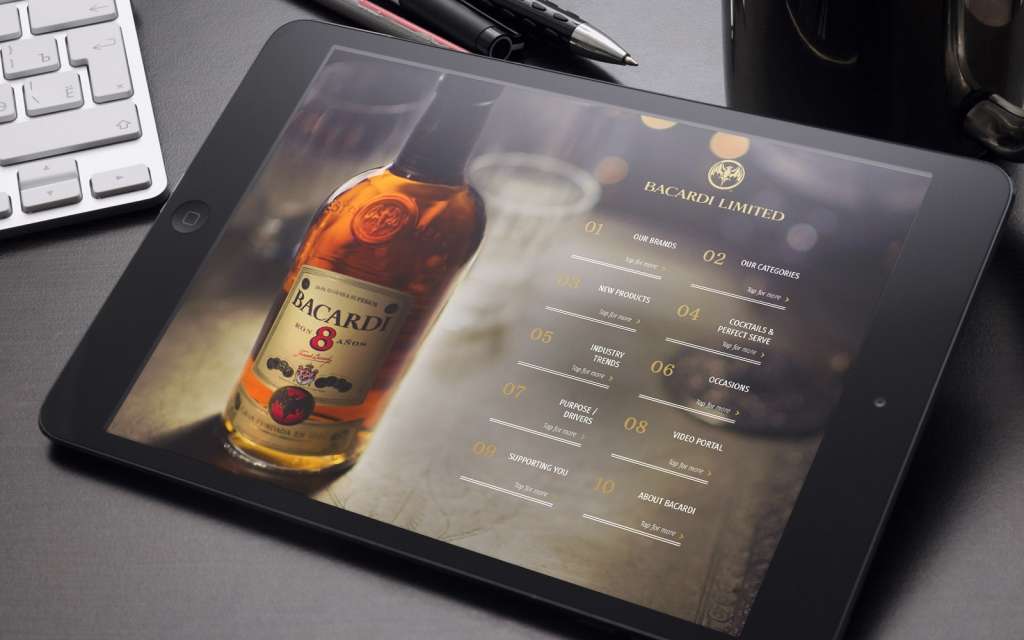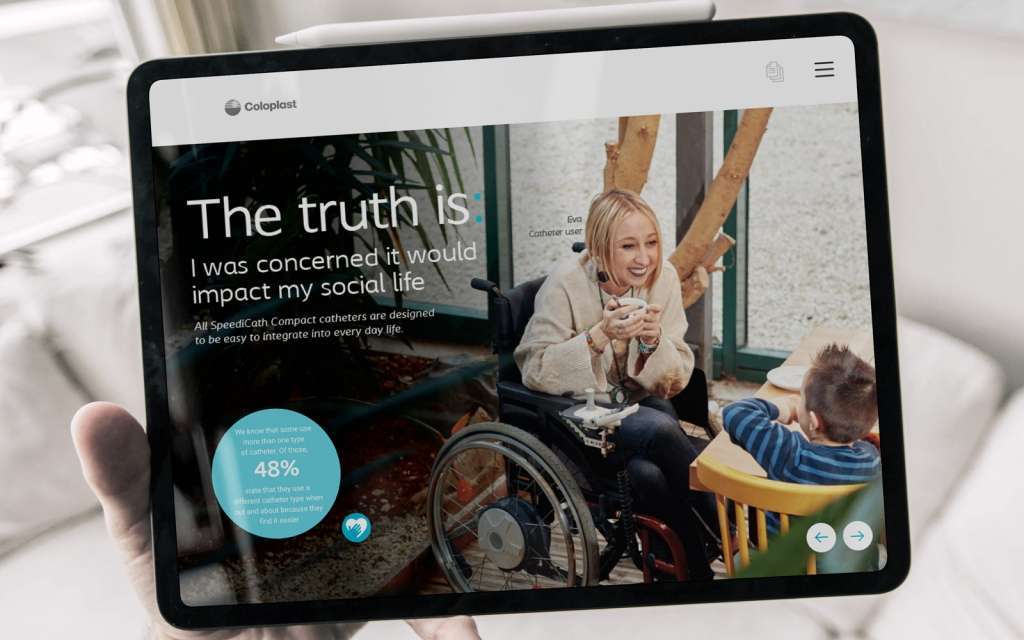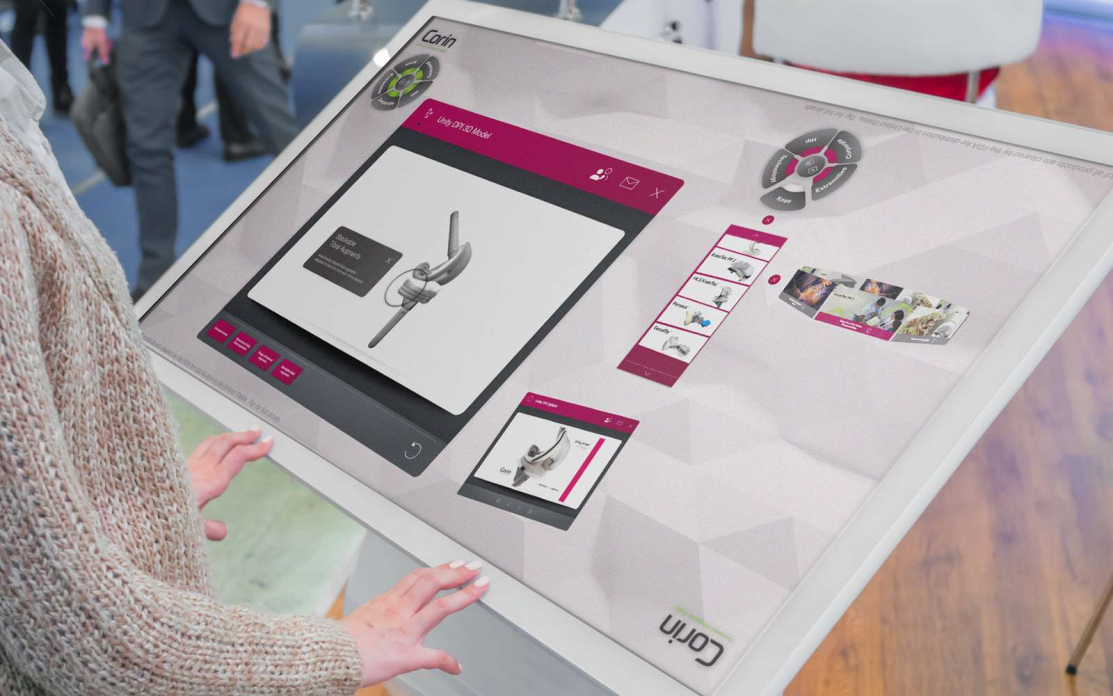“Take-up of a new platform can often be a challenge, even if it ticks every box. It’s so important to get the sales team involved in the development of the sales tool from the very beginning in order to get 100% adoption. POP ran an initial workshop for some of the sales team to offer their insights and requirements.”
Thomas Seymour, Head of UK & Ireland Commercial Capability, Bacardi

B2B sales presentations are changing, we are now firmly in the experience economy with digital sales enablement tools and no-code experience platforms being at the forefront. They play a pivotal role in aiding sales teams and customers during conversations. Their purpose is to help make sense of vast amounts of information, to provide compelling, customised information in an immersive visual experience.
In this blog we’ll explore:
- What a sales enablement tool is – also referred to as a sales platform, sales software or digital sales app – and we’ll delve into the benefits that these tools can deliver for B2B sales
- How a sales enablement platform can be a versatile asset, supporting an omnichannel experience. Whether utilized as a digital sales tool in face-to-face meetings, a touchscreen solution for events, exhibitions, or tradeshows, or a virtual sales experience shared online, its adaptability is a key feature.
- We’ll shine a light on the Discovery Phase, emphasizing its significance in the overall success of the digital sales tool. This phase plays a pivotal role in understanding and addressing the specific needs and challenges of the target audience.
- Furthermore, we’ll underscore the importance of collaborative input from both sales and marketing teams in the development process. By incorporating insights from these teams, the aim is to create a tool that not only proves valuable but is actively embraced and utilized in the field. This collaboration ensures that the sales enablement tool aligns seamlessly with the practical requirements of those on the frontline, enhancing its effectiveness and impact.
What is a sales enablement tool?
Forget the old-school sales pitch—welcome to the era of sales enablement tools, or as we like to call them, revenue rockstars! These tools give your sales teams the power to ditch the one-size-fits-all approach. Now, they can their tailor content on the fly based on who they’re talking to, fostering that all important collaborative conversation and effortlessly showcasing the awesomeness of your products, skills, and value you bring to the table. It lets them instantly grab the latest, coolest, and totally on-brand information personalised for each customer, harnessing creative content, including 3D models, videos, AR tricks, live data—a sales enablement tool has got it all! It’s not just a sales pitch; it’s a show that wows customers and leaves them itching to discover more. The interactive sales app is like magic for sales reps!

Digital B2B sales tools’ analytics provide valuable data too. These insights allow you to monitor customer-sales team engagement and support training programs to enhance and drive sales initiatives.
Here’s a recent blog, which delves into the benefits of data driven sales enablement tools for businesses.
What are the first steps to developing a successful digital sales enablement experience?
Make no mistake, these can be complex sales tools to develop. Without clear objectives, a defined process agreed up-front and the right people involved at the very start, it is easy for the tool to go off track and not deliver.
It is partly for this reason that we use an Agile methodology at POP to ensure projects are well defined, run smoothly and can be delivered in incremental phases ensuring fast, regular releases and updates to be tested in the field. This will save both, money and effort.
Tip: Find out why an Agile approach to sales tool development reduces risk and delivers ROI faster.
At POP, our development process is a result of years of collaboration with businesses across various sectors. The pivotal phase in this process, which we’ve fine-tuned over time, is so crucial that we’ve registered our own methodology for it—meet the Customer-First Blueprint®. Getting this phase right is paramount, and our approach ensures we’re putting the customer at the forefront of everything we do.
For any sales enablement technology to be successful you have to lay down crystal clear parameters. You must clearly define:
- What success looks like – a vision for your ultimate digital sales tool,
- What the end sales tool looks like and what it enables you, your sales team and customer to do,
- The steps that need to be taken to get to your end vision,
- Who is involved and the effort and input required from everybody involved.
Here are the five steps towards the delivery of the Customer-First Blueprint®:
- Survey
- Workshop
- Identify
- Prioritise
- Review
1. The survey
Within your organisation there is an incredible amount of insight, experience and knowledge of what works, and most importantly doesn’t work, when meeting with customers.
The survey unlocks this knowledge, consolidates it so that it’s easy to interpret and then, in the subsequent workshop, we delve into the valuable information it offers with your teams.
The Customer-First Blueprint® survey will give us information on:
- How you currently communicate with your customers,
- What sales and marketing materials and assets are shared with them in meetings,
- The methods that the sales team use to present to their customers,
- What information your customers need from your sales teams and in what format,
- Potential sales tool functionality wish lists from the people who will be using the tool in the field – their insight on what works and doesn’t work with customers.
The survey is anonymous and sent digitally to key stakeholders, sales teams, product teams and anyone else who is involved in customer success. Capturing information from a wide variety of roles is important as it gives, sometimes for the first time, an understanding of how teams are really communicating with customers, what assets they are using and how easily they can access all they need.
It results in powerful, honest, insights into the positive aspects of the current sales process and the pain points encountered when establishing and maintaining successful customer relationships.
It’s also a useful first step in establishing what is needed to align the objectives of the sales and marketing teams more successfully.
2. The Workshop
We play the ‘customer in the room’, facilitating an open and candid discussion with the key people in your organisation who will be using the tool – marketing, sales, customer success teams. It’s important to get all these groups together at the very beginning of the project so that the sales tool meets everyone’s needs and expectations internally, as well as, in regard to the customer.
During their dealings with customers, your teams have amassed stories, anecdotes and preferences about your customer’s unique needs over the years. We use the quantitative data and qualitative insights from the survey to delve more deeply into their personal experience.
This discussion establishes the foundations of your Blueprint for an excellent sales tool, balancing customer experience, sales team requirements and organisational value.
The insights from the survey and the knowledge in the room will enable us to:
- Build an understanding of who your customers really are and what challenges they’re facing,
- See how your organisation is currently working to resolve these challenges,
- Understand what your sales team need from a dream sales tool and what is vital to support their customer engagements,
- Find out what metrics the marketing team needs to capture from the analytics built within the tool,
- Discuss what success looks like for the organisation and what else is needed to create more immersive, valuable and customer-centric conversations.
“We didn’t do anything digital in sales before Coronavirus. POP explained what the terminology meant and held our hand through the process, which is what we needed, especially with such a tight timeframe as well.”
Nick Elliot, Marketing Manager, Coloplast

The insights gathered from Coloplast’s sales team played a key role in shaping the final sales tool currently in use with customers.
3. Identify
Following our workshop, the Customer-First Blueprint® starts to take shape immediately. Within a single document, we’ll start to identify:
- Your business’ customer types
- Where the sales tool will be used – i.e. showroom, customer meeting, trade shows
- What the key tasks are that your sales tool will need to perform – both by customers and the sales team to add value and enhance that relationship
- What content will reside within it
- What type of customer conversations need to be supported and how the information required can be easily accessed
We’ll map out all of the content requirements and look at how this would need to be structured in the final sales tool. This ensures that everything that goes into the future sales tool is focused solely on the need to educate, inform and convert customers.
Within a content map, you can verify that we have captured all of your requirements and highlight if there are any additional elements that need to be included.
You now have the start of a Blueprint which maps out your future sales tool.
4. Prioritise
At this stage, your Blueprint will contain your ultimate wish list of everything that has been discussed; all of the customer and sales team tasks that need to be performed and all of the possible content that could feature in your dream sales tool.
The next stage is to prioritise what is considered ‘core’ within your future sales tool.
We will work with you to evaluate all of the tasks, content and objectives and will prioritise them in order of importance. These will be added to your Blueprint so that they can be discussed in detail.

By focusing on an initial ‘core’ experience, it means that future development is firstly geared towards getting a sales tool in the hands of the sales team as soon as possible. They can start using it in the field and can provide feedback on successes, room for improvement and further development. Over time more and more functionality can be added from your Blueprint. This Agile approach will save you time and money, in addition to ensuring an integrated cross-departmental approach to development.
A great sales tool is a dynamic, growing and changing experience which flexes, amends and improves over time. Your Blueprint will now be a complete roadmap of how this looks.
5. Review
Before your Blueprint is complete and you look forward to the development of the first phase of your exciting new sales tool, it’s important to make sure you reflect on what is being proposed.
We will therefore again facilitate discussions with all key stakeholders and individuals who have been involved in the creation and ideation of the Blueprint to date.
It’s important that something as critical as a customer-facing sales tool is reviewed, verified and reiterated until it represents the best possible roadmap for success for all involved.
Your Blueprint
At the end of the Customer-First Blueprint® process, you’ll have the framework for a highly effective, highly focused customer-centric sales tool.
This single document details everything that your sales tool will encompass in the immediate future but also looking further down the road as to potential functionality and purpose.
It will list:
- Who your customers are
- What challenges they are facing
- What’s important to them
- Where and how you meet with them
It will show:
- Content structure, demonstrating the main sections of the experience and where key content will reside
- How customers can filter and refine the information presented to them, so they get a unique and personalised experience, perfect for understanding how your organisation can solve their needs
- The visual narrative that your sales team can use to support conversations with their customer. As one size doesn’t fit all, it will show the different ways that the sales team can use the sales tool to really help with customer engagement in a way that suits their way of presenting.
Your Blueprint is the map to your future sales tool success, built around your customer, your sales team and your organisation.
What are the advantages of cross-departmental involvement in development?
Collaboration from the very start is incredibly important. It means the difference between creating a tool that meets the needs of all that will be using it or not – it’s as simple as that.
The Customer First Blueprint® Survey and Workshop can often be the first time that sales and marketing have the opportunity or time to really discuss their objectives together and gain consensus.

This collaborative stage is not only crucial to establish the business objectives for the sales enablement technology. It also strengthens the cross-departmental relationships and ensures buy-in from all stakeholders and adoption amongst the teams that will be using the experience with customers.
The Agile approach to development means that the sales tool evolves overtime to meet the needs of the business as a whole.
Analytics embedded within the sales tool track usage and also help departments to work together more closely using current data to have informed discussions on topics including the development of sales and marketing assets and sales team training support.
Sales enablement tool: key takeaways
Not only is a sales enablement tool a powerful platform to communicate more effectively and meaningfully with your customers. It’s also a demonstration of a truly collaborative project within a business, which can help to align sales and marketing towards common goals. As clearly articulated by one of our clients:
“We could have built an awesome looking sales tool, but if it doesn’t solve an immediate need that the sales team are facing then it isn’t going to be of use or useful.”
Dan Cheung, Marketing Manager, Wienerberger
Try sales enablement technology today
At POP, we collaborate with our clients to craft interactive sales experiences using POP’s no-code digital experiences platform. Our goal is to align these experiences with business objectives, providing opportunities for our clients’ sales teams to stand out from the competition and sell effectively.
If you have any questions or have a project in mind, get in touch today on +44 (0)117 329 1712 or hello@popcomms.com. We’d love to hear from you!
Related Posts

How to Measure the ROI of an Interactive Touchscreen Experience
Read

Interactive Touchscreen Experience vs Touchscreen Website
Read

Six Essential Aspects for the Successful Implementation of a Digital Sales Enablement Tool
Read

How to Impress Customers With a World Class Sales Enablement Tool
Read